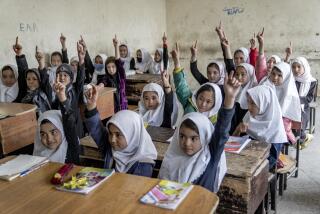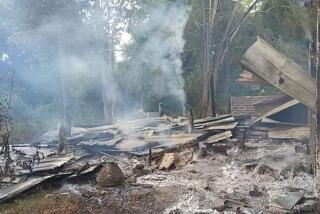The Taliban’s war on education
- Share via
ONE MORNING late last year, Setareh’s students found a landmine in their classroom. It was hidden under a bag in the mud-brick building of the first girls school in her rural Afghan village.
The landmine was not, of course, unexpected. The Taliban had posted a note in the village mosque a few weeks earlier, ordering all girls schools to close. And another “night letter” left at a nearby school had warned: “Respected Afghans: Leave the culture and traditions of the Christians and Jews. Do not send your girls to school.” Otherwise, it said, the mujahedin of the Islamic Emirates, the name of the former Taliban government, “will conduct their robust military operations in the daylight.”
The United States has trumpeted its role in putting Afghan girls back in school as one of the most positive developments since it toppled the Taliban in 2001. On International Women’s Day, March 8, President Bush declared: “Today in Afghanistan, girls are attending school. That speaks well for Afghanistan’s future.” But Setareh, her students and most other Afghan girls are still fighting for that future.
Even before the recent upsurge in fighting in southern Afghanistan, fewer than half of primary-school-age girls were in school. Nearly a third of the country’s districts had no girls schools at all. That’s not to say that commendable gains haven’t been made: 5.2 million students are enrolled in school. When the Taliban fell in 2001, only about 775,000 children were in school, the World Bank estimated.
That’s an accomplishment. Still, 5.2 million is only a bit more than half of all Afghan children, and this modest progress is in danger of unraveling. The Taliban has been targeting boys schools and coeducational schools that offer the secular education promoted by the central government, and especially girls schools. They have killed teachers, threatened students and burned schools. Based on my research on the ground in Afghanistan, I believe that hundreds of thousands of students who were attending school are now shut out, especially in the south and southeast.
Over just four days in December, armed men shot and killed a teacher, a school gatekeeper and a male student in Helmand province. An instructor had been warned to stop teaching girls and boys in the same classroom. In January, armed men in Zabul province beheaded a high school headmaster in front of his children. By March, half of the schools in the province had closed. Afghan education officials say that attacks now average one school a day.
The Taliban is responsible for many of these attacks, but local warlords seeking to further their power and criminal groups (often involved in Afghanistan’s booming narcotics trade) also are targeting schools. Setareh’s village is far from Taliban areas in Wardak province, which is controlled by warlords ostensibly loyal to the government. But a district official told me that it was the local warlord’s thugs who planted the landmine. The official was afraid even to say the warlord’s name out loud. The landmine was safely removed, but Setareh has moved her lessons to a private courtyard, and she asked me not to print her real name.
The Afghan government, which depends on international support, needs a strategy to monitor, prevent and respond to attacks on education. It must sack local commanders hostile to the education of girls, strengthen Afghanistan’s feeble police force and order it to investigate, arrest and prosecute those responsible for threats or attacks.
As I talked with Setareh, it grew late, and my male colleagues, waiting outside while I spoke with her, sent in a boy with a note suggesting that we head back to Kabul before nightfall. But before we left, Setareh wanted to show me her photo albums. Inside were orange-tinted snapshots from her days as a university student and young bride in Kabul. In one shot, she and her husband stood behind a cake, laughing. All “before the mujahedin and the Taliban came,” she explained. A teacher and a mother of six, Setareh and her husband fled her native Kabul for his hometown after the Taliban came to power. As one of the only educated women in a village that had never had a girls school, she was determined to start one after the Taliban’s ouster.
“My husband and his family did not want me to teach. They said, ‘You will be killed,’ ” Setareh said. Now she wasn’t smiling. “I will never stop this school.”
If Afghanistan’s teachers are willing to risk everything to educate their children, can’t the international community at least establish a secure environment for them to do so?
More to Read
Sign up for Essential California
The most important California stories and recommendations in your inbox every morning.
You may occasionally receive promotional content from the Los Angeles Times.










